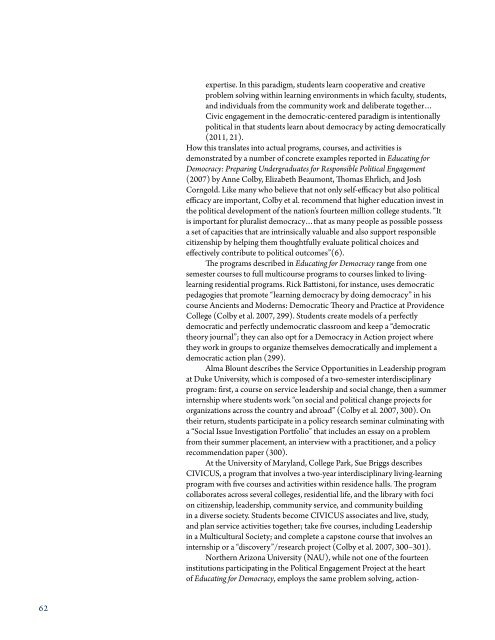MoMent
Crucible_508F
Crucible_508F
You also want an ePaper? Increase the reach of your titles
YUMPU automatically turns print PDFs into web optimized ePapers that Google loves.
62<br />
expertise. In this paradigm, students learn cooperative and creative<br />
problem solving within learning environments in which faculty, students,<br />
and individuals from the community work and deliberate together…<br />
Civic engagement in the democratic-centered paradigm is intentionally<br />
political in that students learn about democracy by acting democratically<br />
(2011, 21).<br />
How this translates into actual programs, courses, and activities is<br />
demonstrated by a number of concrete examples reported in Educating for<br />
Democracy: Preparing Undergraduates for Responsible Political Engagement<br />
(2007) by Anne Colby, Elizabeth Beaumont, Thomas Ehrlich, and Josh<br />
Corngold. Like many who believe that not only self-effcacy but also political<br />
effcacy are important, Colby et al. recommend that higher education invest in<br />
the political development of the nation’s fourteen million college students. “It<br />
is important for pluralist democracy…that as many people as possible possess<br />
a set of capacities that are intrinsically valuable and also support responsible<br />
citizenship by helping them thoughtfully evaluate political choices and<br />
effectively contribute to political outcomes”(6).<br />
The programs described in Educating for Democracy range from one<br />
semester courses to full multicourse programs to courses linked to livinglearning<br />
residential programs. Rick Battistoni, for instance, uses democratic<br />
pedagogies that promote “learning democracy by doing democracy” in his<br />
course Ancients and Moderns: Democratic Theory and Practice at Providence<br />
College (Colby et al. 2007, 299). Students create models of a perfectly<br />
democratic and perfectly undemocratic classroom and keep a “democratic<br />
theory journal”; they can also opt for a Democracy in Action project where<br />
they work in groups to organize themselves democratically and implement a<br />
democratic action plan (299).<br />
Alma Blount describes the Service Opportunities in Leadership program<br />
at Duke University, which is composed of a two-semester interdisciplinary<br />
program: first, a course on service leadership and social change, then a summer<br />
internship where students work “on social and political change projects for<br />
organizations across the country and abroad” (Colby et al. 2007, 300). On<br />
their return, students participate in a policy research seminar culminating with<br />
a “Social Issue Investigation Portfolio” that includes an essay on a problem<br />
from their summer placement, an interview with a practitioner, and a policy<br />
recommendation paper (300).<br />
At the University of Maryland, College Park, Sue Briggs describes<br />
CIVICUS, a program that involves a two-year interdisciplinary living-learning<br />
program with five courses and activities within residence halls. The program<br />
collaborates across several colleges, residential life, and the library with foci<br />
on citizenship, leadership, community service, and community building<br />
in a diverse society. Students become CIVICUS associates and live, study,<br />
and plan service activities together; take five courses, including Leadership<br />
in a Multicultural Society; and complete a capstone course that involves an<br />
internship or a “discovery”/research project (Colby et al. 2007, 300–301).<br />
Northern Arizona University (NAU), while not one of the fourteen<br />
institutions participating in the Political Engagement Project at the heart<br />
of Educating for Democracy, employs the same problem solving, action


